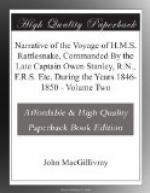With their usual improvidence, the Australians, when they take a turtle, feast upon it until all has been consumed and the cravings of hunger induce them to look out for another; but the Torres Strait Islanders are accustomed to dry the flesh to supply them with food during their voyages. The meat is cut into thin slices, boiled in a melon shell, stuck upon skewers, and dried in the sun. Prepared in this manner it will keep for several weeks, but requires a second cooking before being used, on account of its hardness and toughness. The fat which rises to the surface during the boiling is skimmed off and kept in joints of bamboo and turtle bladders, being much prized as food; I have even seen the natives drink it off in its hot fluid state with as much gusto as ever alderman enjoyed his elaborately prepared turtle soup.
Hawksbill turtle.
The hawksbill turtle (Caretta imbricata) that chiefly producing the tortoise-shell of commerce, resorts to the shores in the neighbourhood of Cape York later in the season than the green species, and is comparatively scarce. It is only taken at night when depositing its eggs in the sand, as the sharpness of the margin of its shell renders it dangerous to attempt to turn it in the water—indeed even the green turtle, with a comparatively rounded margin to the carapace, occasionally, in struggling to escape, inflicts deep cuts on the inner side of the leg of its captor, of which I myself have seen an instance. Of the tortoise-shell collected at Cape York and the Prince of Wales Islands a small portion is converted into fishhooks, the rest is bartered either to Europeans or to the Island blacks, who fashion it into various ornaments.
Capture of the dugong.
Another favourite article of food is the dugong (Halicore australis) of which a few are killed every year. Although it extends along the east coast of Australia from Moreton Bay to Cape York, it appears to be nowhere very common. About Cape York and Endeavour Strait, the dugong is most frequently seen during the rainy season, at which time it is said by the natives to bring forth its young. When one is observed feeding close inshore* chase is made after it in a canoe. One of the men standing up in the bow is provided with a peculiar instrument used solely for the capture of the animal in question. It consists of a slender peg of bone, four inches long, barbed all round, and loosely slipped into the heavy, rounded, and flattened head of a pole, fifteen to sixteen feet in length; a long rope an inch in thickness, made of the twisted stems of some creeping plant, is made fast to the peg at one end, while the other is secured to the canoe. When within distance, the bowman leaps out, strikes the dugong, and returns to the canoe with the shaft in his hand. On being struck, the animal dives, carrying out the line, but generally rises to the surface and dies in a few minutes, not




